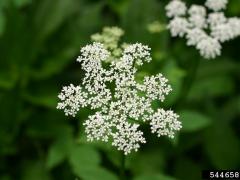Invasive Species: Aegopodium podagraria, Bishops Goutweed
Bishops goutweed is an invasive creeping perennial that can grow to 3 ft. (1 m) tall. The compound leaves are alternate and have sheathing bases. The leaves at the top of the stem are smaller and have fewer leaflets. The leaflets are dentate and 1 to 3 in. (2.5 to 7.6 cm) long. Blooming occurs in June, when a flat, 2 to 4 in. (5 to 10 cm) wide cluster of small white flowers develops. Bishops goutweed flourishes in moist, shaded areas such as forest edges and disturbed forests. It is native to Europe and northern Asia and was introduced to North America as an ornamental.
What are invasive species and why should we be concerned about them?
Taxonomy: Scientific and Common Names for This Species
Apiales > Apiaceae > Aegopodium podagraria L.
none
Aegopodium podagraria – USDA PLANTS Profile
Distribution Maps
Bishops goutweed – The reported distribution of this invasive species across the United States. (Source: Invasive Plant Atlas of the United States)
Up-to-the-minute distribution maps and why they are important
Reporting This Invasive Species
What is the best way and place to report the occurrence of an invasive species?
How to report an invasive species sighting to EDDMapS – Early Detection & Distribution Mapping System
EDDMapS – Report an invasive species to EDDMapS
Cooperative Extension Offices – Find your local Cooperative Extension office on this map provided by USDA
How to Identify
This invasive species can be identified by looking for the characteristics described in the paragraphs that follow.
Plant
An invasive creeping perennial that can grow to 3 ft. (1 m) tall.
 |
 |
|
Leslie J. Mehrhoff, University of Connecticut, |
Robert Vidéki, Doronicum Kft., bugwood.org |
Foliage
The compound leaves are alternate and have sheathing bases. The leaves at the top of the stem are smaller and have fewer leaflets. The leaflets are dentate and 1 to 3 in. (2.5 to 7.6 cm) long.
 |
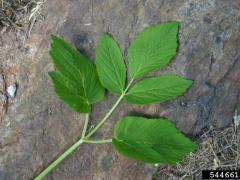 |
| Leslie J. Mehrhoff, University of Connecticut, bugwood.org | Leslie J. Mehrhoff, University of Connecticut, bugwood.org |
Flower
Blooming occurs in June, when a flat, 2 to 4 in. (5 to 10 cm) wide cluster of small white flowers develops.
|
|
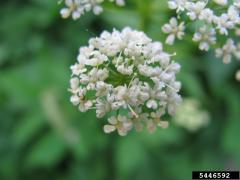 |
| Leslie J. Mehrhoff, University of Connecticut bugwood.org | Leslie J. Mehrhoff, University of Connecticut, bugwood.org |
Fruit
 |
|
| Leslie J. Mehrhoff, University of Connecticut, bugwood.org | bugwood.org |
Native Species That Resemble Bishops Goutweed
Heracleum maximum, common cowparsnip – Images at invasive.org
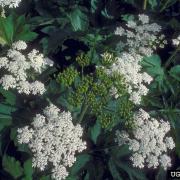 |
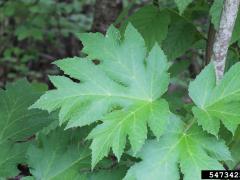 |
|
Dave Powell, USDA Forest Service (retired), |
Rob Routledge, Sault College,bugwood.org |
– Images at invasive.org
| bugwood.org | bugwood.org |
Additional Images for Bishops Goutweed
Bishops goutweed – Images at Invasive.org
Learning Resources for Bishops Goutweed
Fact Sheet – Pennsylvania Dept. of Conservation and Natural Resources
Additional Information, Biology, Control and Management Resources
Control and management recommendations vary according to individual circumstances. Location, habitat, weather, and a variety of other conditions are factors that help determine the best treatment choice. To find the safest and most effective treatment for your situation, consult your state’s land-grant institution. If you will use chemicals as part of the control process, always refer to the product label.
United States Land-Grant University System – Find your land-grant university’s College of Agriculture, Cooperative Extension Service, or other related partner on this map provided by USDA.
Weeds Gone Wild: Alien Plant Invaders of Natural Areas – Plant Conservation Alliance
Invasive Plants of Wisconsin – University of Wisconsin-Green Bay
Fact Sheet – Ohio State University
Invasive Fact Sheet – The Nature Conservancy

